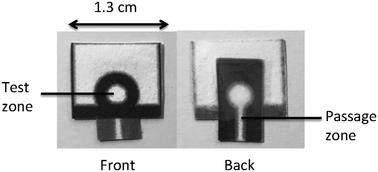Our official English website, www.x-mol.net, welcomes your
feedback! (Note: you will need to create a separate account there.)
Paper-based human neutrophil elastase detection device for clinical wound monitoring.
Lab on a Chip ( IF 6.1 ) Pub Date : 2020-06-23 , DOI: 10.1039/d0lc00062k Ting Yang,Shin-Chen Pan,Chao-Min Cheng
Lab on a Chip ( IF 6.1 ) Pub Date : 2020-06-23 , DOI: 10.1039/d0lc00062k Ting Yang,Shin-Chen Pan,Chao-Min Cheng

|
Paper-based diagnostic devices have been widely applied to assess the presence and status of a variety of clinical diseases by analyzing samples such as urine or blood. Due to their low cost, user-friendliness, and convenience, they have been used as point-of-care (POC) devices in countries lacking resources or energy. Despite wide-ranging research and implementation, paper-based devices have not previously been developed for wound analysis. Here, we discuss the successful development of such a tool to facilitate simple and rapid wound status assessment. The purpose of this study was to develop a paper-based elastase detection device (PEDD) for clinical wound assessment that specifically examines human neutrophil elastase (HNE), one of the most abundant serine proteases found in chronic wounds. The first step in this study was an examination of different paper substrate types (i.e., chromatography paper and filter paper) to determine which provided the best protease immobilization and colorimetric response. We then used a wax printing approach to create hydrophobic and hydrophilic regions and designated test zones created on both chromatography and filter papers. This allowed us to physically immobilize both substrate and protease within the desired test zone regions. This PEDD which demonstrated good sensitivity (0.631 μg mL−1, in a wound fluid system) can be used to monitor protease activity expressed in wounds. After developing this device, we examined samples from 9 patients presenting a total of 7 acute and 4 chronic wounds to determine wound HNE concentration. We believe that this study may be widely applicable in both academic and commercial sciences, including the development of practical POC detection devices.
中文翻译:

纸基人嗜中性粒细胞弹性蛋白酶检测设备,用于临床伤口监测。
通过分析诸如尿液或血液的样本,纸质诊断设备已广泛应用于评估各种临床疾病的存在和状况。由于它们的低成本,用户友好性和便利性,它们已被用作缺乏资源或能源的国家中的即时医疗(POC)设备。尽管进行了广泛的研究和实施,但以前尚未开发出用于伤口分析的纸质设备。在这里,我们讨论了这种工具的成功开发,以促进简单,快速的伤口状态评估。这项研究的目的是开发一种用于临床伤口评估的纸质弹性蛋白酶检测装置(PEDD),该装置专门检查人类嗜中性粒细胞弹性蛋白酶(HNE),这是在慢性伤口中发现的最丰富的丝氨酸蛋白酶之一。(例如,色谱纸和滤纸)以确定哪种蛋白酶可提供最佳的固定化和比色反应。然后,我们使用蜡印刷方法在色谱纸和滤纸上创建疏水和亲水区域以及指定的测试区域。这使我们可以将底物和蛋白酶物理固定在所需的测试区域内。该PEDD表现出良好的灵敏度(0.631μgmL -1(在伤口液系统中),可用于监测伤口中表达的蛋白酶活性。开发此设备后,我们检查了9名患者的样品,这些患者总共出现了7个急性伤口和4个慢性伤口,以确定伤口的HNE浓度。我们相信这项研究可能会广泛应用于学术和商业科学,包括开发实用的POC检测设备。
更新日期:2020-07-29
中文翻译:

纸基人嗜中性粒细胞弹性蛋白酶检测设备,用于临床伤口监测。
通过分析诸如尿液或血液的样本,纸质诊断设备已广泛应用于评估各种临床疾病的存在和状况。由于它们的低成本,用户友好性和便利性,它们已被用作缺乏资源或能源的国家中的即时医疗(POC)设备。尽管进行了广泛的研究和实施,但以前尚未开发出用于伤口分析的纸质设备。在这里,我们讨论了这种工具的成功开发,以促进简单,快速的伤口状态评估。这项研究的目的是开发一种用于临床伤口评估的纸质弹性蛋白酶检测装置(PEDD),该装置专门检查人类嗜中性粒细胞弹性蛋白酶(HNE),这是在慢性伤口中发现的最丰富的丝氨酸蛋白酶之一。(例如,色谱纸和滤纸)以确定哪种蛋白酶可提供最佳的固定化和比色反应。然后,我们使用蜡印刷方法在色谱纸和滤纸上创建疏水和亲水区域以及指定的测试区域。这使我们可以将底物和蛋白酶物理固定在所需的测试区域内。该PEDD表现出良好的灵敏度(0.631μgmL -1(在伤口液系统中),可用于监测伤口中表达的蛋白酶活性。开发此设备后,我们检查了9名患者的样品,这些患者总共出现了7个急性伤口和4个慢性伤口,以确定伤口的HNE浓度。我们相信这项研究可能会广泛应用于学术和商业科学,包括开发实用的POC检测设备。











































 京公网安备 11010802027423号
京公网安备 11010802027423号